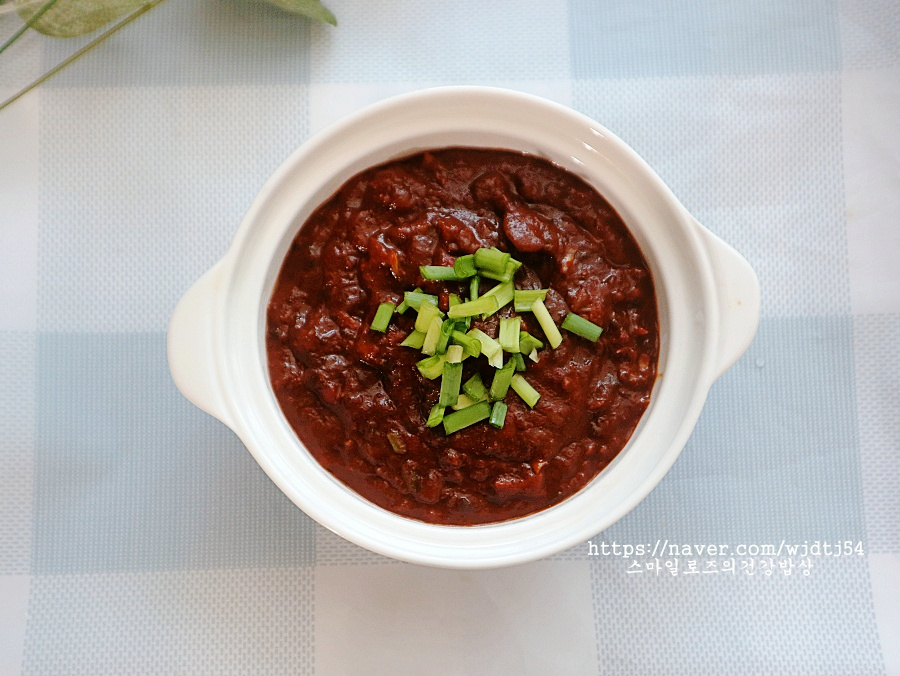Hearty Tuna Ssamjang (Korean Dipping Sauce)
Baek Jong-won’s Delicious Tuna Ssamjang Recipe – A Non-Salty, Flavorful ‘Gang-doenjang’ Style

Craving the perfect wrap (ssam) experience but find store-bought ssamjang too salty? This recipe offers a delightful homemade alternative! Packed with fresh vegetables and boasting a balanced, savory flavor, this Tuna Ssamjang is a healthier choice. It’s perfect for enjoying with a variety of fresh greens, including cabbage wraps which are great for diet-conscious individuals. Make a batch to last through the week, reduce your rice intake, and enjoy the satisfying fullness of vegetables!
Main Ingredients- 1 can (85g) Tuna, including the oil
- 1 Onion (approx. 80g)
- A small bunch of Scallions (or white part of Leeks)
- 1 Korean Green Chili Pepper (for heat, optional)
- 1 Red Chili Pepper (for color and mild sweetness)
- 1 cup Water (200ml)
Seasoning- 2 Tbsp Doenjang (fermented soybean paste)
- 2 Tbsp Gochujang (red chili paste)
- 2 Tbsp Gochugaru (red chili flakes, adjust to taste)
- 1 Tbsp Sesame Oil (for finishing)
- 2 Tbsp Doenjang (fermented soybean paste)
- 2 Tbsp Gochujang (red chili paste)
- 2 Tbsp Gochugaru (red chili flakes, adjust to taste)
- 1 Tbsp Sesame Oil (for finishing)
Cooking Instructions
Step 1
Hello everyone! Today, I’m excited to share a recipe for a hearty and healthy ‘Baek Jong-won Style Tuna Ssamjang’. This versatile dipping sauce is perfect for creating delicious ssam (wrap) meals. Let’s dive into how to make a flavorful ssamjang that’s not too salty!

Step 2
Recently, I enjoyed a wonderful meal with steamed cabbage wraps generously topped with this tuna ssamjang. It was incredibly satisfying without being overly salty! It’s also fantastic mixed with rice, especially when paired with side dishes like seasoned radish (mu-saengchae) or seasoned bean sprouts (sukju-namul muchim), turning it into a complete and delicious one-bowl meal.

Step 3
First, prepare your can of tuna. Don’t discard the oil; it’s crucial for building flavor! Finely mince the onion. For aromatics, I’m using fresh green onion sprouts today, but you can also use chopped scallions or the white part of leeks. Finely chop the Korean green chili pepper and red chili pepper, removing the seeds if you prefer less heat.

Step 4
Open the can of tuna. Place the lid back on the can and press down firmly to drain the tuna oil directly into your pot. This oil will form the flavorful base for our stir-fry.

Step 5
Add the minced onion sprouts (or scallions/leeks) and minced garlic to the pot with the tuna oil. Sauté over medium-low heat until fragrant. Once the onion sprouts become slightly translucent and aromatic, add the minced onion and continue to stir-fry until the onions are softened and translucent, bringing out their natural sweetness.

Step 6
Once the onions are well sautéed, it’s time to add the doenjang (2 Tbsp) and gochujang (2 Tbsp). Stir and cook these pastes for a minute or two. This step helps to mellow out any harshness from the pastes and deepens their savory flavor.

Step 7
After sautéing the pastes, carefully pour in 1 cup of water (200ml). Add 2 Tbsp of gochugaru (red chili flakes) for color and spice. Crucially, reduce the heat to low. Boiling on high heat can cause splattering and burns, so let it simmer gently over low heat. If it starts to bubble vigorously, lower the heat further.

Step 8
Once the mixture begins to simmer gently over low heat, add the drained tuna to the pot. Stir everything together well.

Step 9
Continue to cook over low heat, stirring occasionally to prevent the bottom from sticking. As the sauce thickens and the liquid reduces, add the chopped green and red chili peppers. Let it simmer until the sauce reaches a thick, jam-like consistency.

Step 10
Finally, drizzle in 1 Tbsp of sesame oil for a fragrant finish. Your delicious, savory, and non-salty Tuna Ssamjang is ready! Doesn’t it look appetizing?

Step 11
Transfer the finished Tuna Ssamjang to a serving container. Garnish with a sprinkle of chopped scallions or leeks for a beautiful presentation.

Step 12
Enjoy this ssamjang generously spooned over steamed cabbage leaves or as a topping for rice to make a satisfying ssam-bap (rice wrap). It’s a truly wonderful way to enjoy a meal!

Step 13
While there are simpler recipes where you mix ingredients raw, cooking this ssamjang allows it to be stored in the refrigerator for up to a week as a convenient side dish. I personally prefer this cooked version, inspired by Baek Jong-won’s ‘Tuna Gang-doenjang’. I highly recommend you try it!




